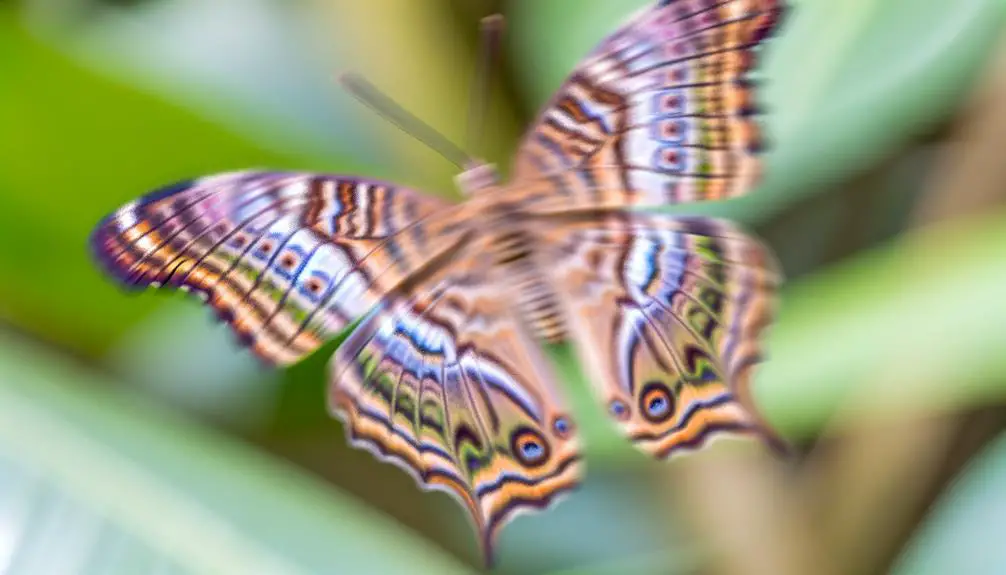Why Do Butterflies Fly So Erratically?
Butterflies exhibit erratic flight patterns due to a combination of evolutionary benefits, predator evasion techniques, and mating behaviors. This unpredictable movement decreases their predictability, complicating predators' efforts to capture them.
Anatomically, their wing structure facilitates sudden changes in direction and speed, enhancing survival. Additionally, these flight patterns help in thermoregulation, exploration of nectar sources, and facilitate courtship displays.
Environmental factors such as wind patterns and temperature also influence their erratic flight. By understanding these dynamics, one gains deeper insights into the complexities of butterfly behavior and survival strategies.

Key Takeaways
- Erratic flight patterns help butterflies evade predators by reducing their predictability.
- Variations in flight paths aid in thermoregulation by altering sunlight exposure.
- Unpredictable maneuvers facilitate efficient exploration for nectar and oviposition sites.
- Erratic flight serves as a courtship display and mate selection mechanism.
Evolutionary Advantages

The erratic flight patterns of butterflies confer several evolutionary advantages, primarily by enhancing their ability to evade predators and increasing their chances of survival. This seemingly chaotic movement is a sophisticated adaptation that reduces predictability, making it challenging for predators to capture them.
Additionally, erratic flight can aid in thermoregulation by varying their exposure to sunlight, optimizing body temperature for physiological processes. This irregular movement also facilitates effective exploration of their habitat, allowing butterflies to efficiently locate nectar sources and suitable sites for oviposition.
Furthermore, the erratic flight can play a role in intraspecific communication, signaling fitness to potential mates and deterring rivals. Consequently, these complex flight behaviors represent a multifaceted evolutionary strategy, integral to their ecological success.
Predator Evasion
Exhibiting erratic flight patterns greatly enhances butterflies' ability to evade predators by creating unpredictable trajectories that complicate the pursuit and capture efforts of predatory species.
This flight behavior, characterized by rapid changes in speed and direction, leverages biomechanics to optimize survival.
Predators such as birds and spiders rely on predictive tracking to capture prey. The nonlinear, stochastic movements of butterflies disrupt this tracking mechanism, reducing capture success rates.
Additionally, their wing coloration and patterns, when combined with erratic flight, create visual illusions that further disorient predators.
This adaptive strategy effectively reduces predation pressure, demonstrating a sophisticated evolutionary response.
Consequently, the erratic flight not only serves as a defensive mechanism but also contributes to the butterflies’ overall fitness and survival. This unpredictable movement makes it harder for predators to capture them, increasing their chances of escape. Additionally, butterflies chasing each other can play a role in mating behaviors or territorial disputes, further influencing their survival. These dynamic interactions highlight the importance of movement in both defense and reproduction.
Mating Behavior

Beyond predator evasion, erratic flight patterns also play a vital role in the mating behavior of butterflies, facilitating courtship displays and mate selection through intricate aerial maneuvers. Such behaviors are not random but are highly structured and species-specific, allowing butterflies to convey fitness and readiness to potential mates. The complexity and diversity of these flight patterns are essential for successful reproduction, influencing mate attraction and copulatory success.
| Behavior | Description |
|---|---|
| Courtship Flights | Males perform spirals and loops to attract females. |
| Territorial Displays | Males defend areas, showcasing their vigor. |
| Chasing | Males pursue females in erratic patterns. |
| Hovering | Males hover near females to signal readiness. |
| Wing Vibrations | Males vibrate wings to produce acoustic signals. |
Such behaviors underscore the importance of flight dynamics in the reproductive ecology of butterflies.
Navigational Skills
Butterflies exhibit erratic flight patterns as part of their sophisticated navigational skills, primarily to evade predators through unpredictable maneuvering tactics.
Additionally, their flight path is greatly influenced by their ability to skillfully navigate wind and air currents, which they use to conserve energy and maintain control.
Understanding these factors provides insight into the complexities of butterfly locomotion and survival strategies.
Evasive Maneuvering Tactics
A key component in the erratic flight patterns of butterflies is their ability to execute rapid and unpredictable maneuvers, which serve as an effective defense mechanism against predators.
These maneuvers involve sudden changes in direction, altitude, and speed, creating a complex flight path that is difficult for predators to predict and intercept.
The butterfly's lightweight structure, combined with highly responsive wing muscles and advanced neural control systems, enables these agile movements.
Additionally, the asymmetrical flapping of their wings generates varying aerodynamic forces, allowing for quick lateral shifts and rotations.
Such sophisticated evasive tactics greatly enhance their survival by reducing the likelihood of successful predation, illustrating the intricate evolutionary adaptations butterflies have developed to navigate their environments defensively.
Wind and Air Currents
Mastery of wind and air currents is essential for butterflies, as their ability to interpret and navigate these environmental factors greatly enhances their flight efficiency and energy conservation.
Butterflies possess highly sensitive mechanoreceptors on their antennae and wings, which detect minute changes in air pressure and wind direction. This sensory input allows them to make rapid, precise adjustments to their flight path, exploiting updrafts and avoiding turbulence.
Additionally, their erratic flight patterns can be attributed to strategic use of microclimates, where slight variations in temperature and humidity influence air currents.
Such aerodynamic proficiency not only reduces the energetic cost of flight but also facilitates long-distance migration and effective foraging, demonstrating an intricate balance between environmental interaction and physiological adaptation.
Wing Structure

Intricately designed with a complex network of veins and scales, the wing structure of butterflies plays a pivotal role in their characteristic erratic flight patterns.
The wings are composed of two membrane layers supported by veins that provide structural integrity and flexibility. The arrangement and density of scales on these membranes not only contribute to the coloration and thermoregulation but also affect aerodynamic properties.
Variations in wing morphology, including asymmetrical shapes and differing stiffness across the span, create non-uniform lift and thrust. This irregular aerodynamic force distribution results in the unpredictable and seemingly chaotic flight paths observed.
Additionally, the lightweight yet robust composition of the wings allows for rapid, agile maneuvers, further contributing to the erratic flight behavior.
Environmental Factors
Environmental factors, including wind patterns, temperature fluctuations, and predator presence, greatly influence the erratic flight behavior of butterflies.
Wind patterns can create turbulent air currents, necessitating rapid adjustments in flight trajectory to maintain stability.
Temperature fluctuations impact the metabolic rate of butterflies, altering their energy reserves and flight dynamics.
Predators such as birds and spiders induce erratic flight as a defensive mechanism; sudden, unpredictable movements make it harder for predators to capture them.
Additionally, the availability of nectar sources and suitable habitats can compel butterflies to change their flight paths frequently.
Understanding these environmental influences provides a thorough insight into the adaptive behaviors of butterflies, revealing how they navigate complex ecosystems and enhance their survival prospects through seemingly erratic flight patterns.
Conclusion
The erratic flight of butterflies emerges as a confluence of evolutionary advantages, serving both predator evasion and mating behavior, while being influenced by wing structure and environmental factors.
The seemingly chaotic navigation reveals a sophisticated set of skills, juxtaposing randomness with precision.
These multifaceted elements coalesce to optimize survival and reproductive success, illustrating the intricate balance between nature and adaptation.
Through this lens, the erratic flight pattern is not mere whimsy but an evolved strategy of remarkable complexity.






